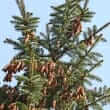Background
- Canada balsam is a small-to-medium-sized fir tree native to North America and Canada. Its needles are shiny and dark green on the outside and matte, silvery blue-green on the underside. Canada balsam is sometimes mistaken for balm of Gilead, a tree in the Poplar genus.
- Historically, Native Americans have applied Canada balsam to the skin as a poultice to treat burns and wounds. During the Civil War, balm of balsam fir was reportedly used to treat combat injuries. The essential oil of Canada balsam has been used for coughs and colds.
- Canada balsam resin is a clear, transparent, and adhesive liquid, with a consistency similar to honey. Purified Canada balsam resin is used as an optical glue, a microscopic prepping agent, and as a fixative and glossing agent in oil painting. Canada balsam resin is also used in combination with other substances in dental procedures. Oils extracted from the resin have been studied experimentally for their antitumor and antibacterial activities. The trunk of Canada balsam also yields oil used for making glassware.
- Currently, high-quality trials investigating the use of Canada balsam for any medical condition are lacking.
- Canada balsam is listed on the U.S. Food and Drug Administration (FDA) Generally Recognized as Safe (GRAS) list.
References
Natural Standard developed the above evidence-based information based on a thorough systematic review of the available scientific articles. For comprehensive information about alternative and complementary therapies on the professional level, go to . Selected references are listed below.
- Gugliotta, P, Pacchioni, D, and Bussolati, G. Staining reaction for beta-galactosidase in immunocytochemistry and in situ hybridization. Eur J Histochem 1992;36(2):143-148.
View Abstract - Humphrey, CD and Pittman, FE. Influence of mounting media on the fading of basic aniline dyes in epoxy embedded tissues. Stain Technol 1977;52(3):159-164.
View Abstract - Keen, CE, Buk, SJ, Brady, K, et al. Fat necrosis presenting as obscure abdominal mass: birefringent saponified fatty acid crystalloids as a clue to diagnosis. J Clin Pathol 1994;47(11):1028-1031.
View Abstract - Legault, J, Dahl, W, Debiton, E, et al. Antitumor activity of balsam fir oil: production of reactive oxygen species induced by alpha-humulene as possible mechanism of action. Planta Med 2003;69(5):402-407.
View Abstract - Orstavik, D. Endodontic materials. Adv Dent Res 1988;2(1):12-24.
- Padilha-Goncalves, A. A single method to stain Malassezia furfur and Corynebacterium minutissimum in scales. Rev.Inst.Med Trop.Sao Paulo 1996;38(4):299-302.
View Abstract - Pichette, A, Larouche, PL, Lebrun, M, et al. Composition and antibacterial activity of Abies balsamea essential oil. Phytother Res 2006;20(5):371-373.
View Abstract - Shivapathasundharam, B and Berti, AE. Transparent tooth model system. An aid in the study of root canal anatomy. Indian J Dent.Res 2000;11(3):89-94.
View Abstract - Tveit, AB and Hals, E. Inhibitory effect of a fluoride-containing amalgam on development of cavity wall lesions in vitro. Acta Odontol Scand 1980;38(1):29-39.
View Abstract - Zmener, O, Goldberg, F, and Cabrini, RL. Effects of two gutta-percha formulations and one zinc oxide-eugenol and Canada balsam mixture on human blood monocytes and lymphocytes. Endod Dent Traumatol 1989;5(2):73-77.
View Abstract - Array







